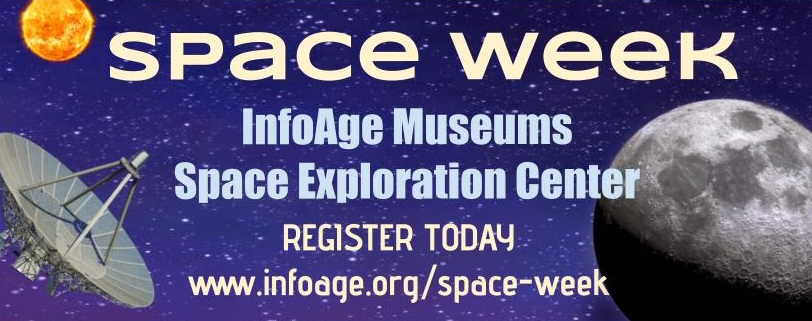The History of InfoAge Science & History Museums
Camp Evans and Sputnik Camp Evans and Sputnik
Camp Evans and Sputnik
History changed on October 4, 1957, when the former Soviet Union successfully launched Sputnik I. Besides the bruising to national prestige it started the ‘SPACE RACE’. A part of the race was a push to ‘catch-up’ and exceed the Soviets in the fields of space science and science education.
Following the Soviet launch of Sputnik, Congress responded to the perceived technology gap in the United States bypassing the National Defense Education Act that funded new science, math, and foreign language programs in American schools. As one college president argued in the 1960s: colleges and universities were now “bastions of our defense, as essential as … supersonic bombers.” (1). To this day educators divide science education in the U.S. as pre-Sputnik and post-Sputnik periods.
Another reaction was the formation of the Advanced Research Projects Agency (ARPA), its general charter was to help the nation avoid technological surprises such as Sputnik. It has since produced a cornucopia of technological results that have benefited U.S. national security in myriad ways, both directly in militarily relevant results and indirectly through the expansion of the country’s technology base, upon which industry has drawn to produce new businesses, products, and services not possible before. To facilitate internal communications ARPA created the ARPANET which eventually lead to the Internet. (2)
To the U.S. Army Signal Corps scientists at Camp Evans in Wall Township and Deal Test site in Ocean Township, the launch was a very personal life-changing event. For weeks they labored marathon hours tracking this ‘invader’ from the Soviet Union in TOP-SECRET. Using the tracking equipment at Diana Site on Marconi Road and antennas at Deal they characterized the Sputnik. The Institute for Exploratory Research was created and based at Camp Evans. Dr. Stanley Kronenberg was one of the section heads. Dr. Kronenberg still carries on research at Camp Evans to this day. It is very fitting that the equipment located at Camp Evans, specifically at the Diana Site, was one of the first to detect the ‘beep-beep-beep’ of Sputnik. It was at this location in 1946 that Lt. Col. John DeWitt and his group in Project Diana bounced a radar signal off the moon. To the public, this was a science event which was the birth of Radio Astronomy and to some the start of the ‘Space Age’. To the US Army scientists at Camp Evans, it was the first step to developing the ability to track Soviet ballistic missiles above the ionosphere and protect the US from atomic attack. According to actor Jack Nicholson’s account in the film ‘EASY RIDER, the radar waves emitted from Wall alerted aliens to mankind’s presence on earth.
In 1946 radar could not ‘see’ through the ionosphere and our military felt blind to Soviet ballistic missiles. To find some humor in the long hours of dedication, and cutting edge electronic work the scientists formed ‘ROOSCH’ – the Royal Order Of Sputnik Chasers. A commendation and diploma were given to all U.S. Army Signal Corps employees who donated more than 100 hours to tracking Sputnik.(3) There are surely Wall residents who worked at Camp Evans who earned a ROOSCH commendation. Later some of these same scientists would help in the development at Camp Evans of the electronics package for our reply to Sputnik, the first U.S. satellite, Vanguard I. Vanguard was launched on March 17, 1958 (4). Then in December of 1958, the SCORE satellite was launched. Built as a TOP-SECRET project at Camp Evans, this was the first pride restoring space advance by the U.S. Before SCORE, every American launch was a ‘Me Too’ in reply to each Soviet ‘first’. In the 1960s much of this pioneering space work was transferred to NASA. Many of the Camp Evans scientists left Wall Township and the U.S. Army Signal Corps to work for NASA. Each October 4th, more than a few Wall residents will remember when they answered their nation’s call and in TOP-SECRET contributed to the ‘Space Race’ at Camp Evans.
(1) Scientifically Illiterate vs. Politically Clueless Gregory E. van der Vink, SCIENCE Volume 276, Number 5316, Issue of 23 May 1997, p. 1175 (2) Research Pays Off Science 1996 March 8; 271 (5254):1343 (in Editorial) V. G. Cerf (3) From an Early Sputnik Diary, IRE Transactions on Military Electronic, April-July 1960, p.320, Harold A. Zahl (4) Evaluation of Selected Cultural Resources at Fort Monmouth New Jersey: Context for Cold War Era, Revision of Historic Properties Documentation, and Survey of Evans Area and Sections of Camp Charles Wood U.S. Army Corps of Engineers by New South Associates, June 1996 p. 38.
Page updated October 3, 2017, page created March 27, 1999
We Need Your Help! Volunteer with Us.
Join our mission to preserve historic Camp Evans and teach the public about science and history.
Sign up to join our team of volunteers and start on your own mission today.
InfoAge Science & History Museums
2201 Marconi Road
Wall, NJ 07719
Tel: 732-280-3000
info@infoage.org
webmaster@infoage.org


